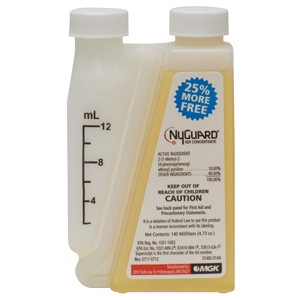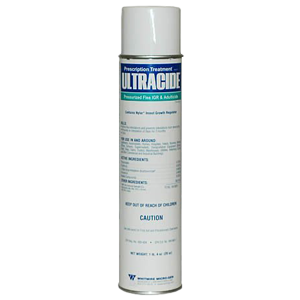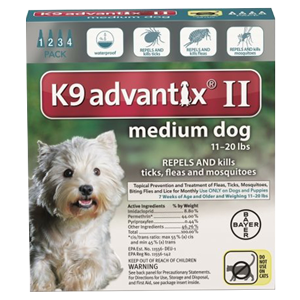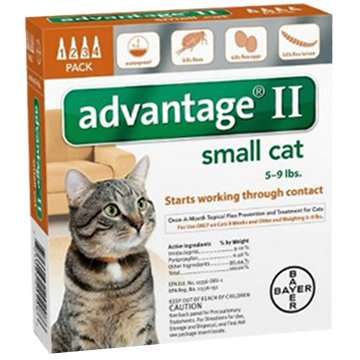Pyriproxyfen is an active ingredient found in a variety of pest control products, ranging from flea drops to spray concentrates. It works by mimicking a natural hormone within insects, namely the one responsible for metamorphosis. Used indoors, it stops larvae from developing for up to 7 months.
 |
 |
 |
 |
|
| Product Name | NyGuard IGR | Ultracide Professional | K9 Advantix II | Bayer Advantage II |
| Price | $45 | $25 | $45 | $40 |
| Size | 4.73 ounces | 20 ounces | 4 tubes | 4 tubes |
| Capacity | 52500 sq ft | 2625 sq. ft | – | – |
| Price / 100 sq ft | $0.09 | $0.95 | – | – |
| Application | Spray Concentrate | Aerosol | Squeeze-On | Squeeze-On |
| Use On | Yards or Indoors | Carpets | Dogs | Cats |
| Kills | Eggs Larvae |
Eggs Larvae Adults |
Eggs Larvae Adults |
Eggs Larvae Adults |
| Active Ingredients | Pyriproxyfen | Pyriproxyfen Permethrin Pyrethrins Synergists |
Pyriproxyfen Imidacloprid Permethrin |
Pyriproxyfen Imidacloprid |
| A.I. Concentration | 10% | 0.10% 0.40% 0.05% 0.40% |
0.44% 8.80% 44.00% |
0.46% 9.10% |
| Duration | Outdoors: 3 weeks Indoors: 7 months |
7 months | 4 months | 4 months |
| Product Label | ||||
| MSDS | ||||
| FleaScore | ||||
| Reviews |
- Prices are approximations based off of Amazon.com prices at the time of publishing.
- FleaScores are based off of product details (price, size, active ingredients, etc), as well as reviews aggregated from 3rd party sources.
What is Pyriproxyfen?
Pyriproxyfen (PPF) is an insect growth regulator (IGR). IGRs are compounds which mimic natural insect hormones, specifically those which control development and fertility. IGRs overload an insect’s hormonal system, ultimately affecting physical growth, egg production, brood care and social interaction.
There are two primary categories of IGRs: juvenile hormone analogues (JHA) and chitin synthesis inhibitors. Pyriproxyfen belongs to the former. JHAs are also called juvenoids or juvenile hormone mimics. There are two subgroups of JHAs: terpenoids (e.g. methoprene), and phenoxy JHAs (e.g. pyriproxyfen).
Pyriproxyfen
Chemical Overview
| Chemical type | Juvenile hormone analog |
| Developer | Sumitomo |
| Developed in | 1985 |
| Common name | Pyriproxyfen |
| Trade names | Sumilarv®, Nylar®, Virbac®, Emax®, Cyclio® |
| IUPAC names | 4-phenoxyphenyl (RS)-2-(2-pyridyloxy)propyl ether 2-[1-(4-phenoxyphenoxy)propan-2-yloxy]pyridine |
| CA name | 2-[1-methyl-2-(4-phenoxyphenoxy)ethoxy]pyridine |
| CAS No. | 95737-68-1 |
| Molecular formula | C20H19NO3 |
| Molecular mass | 321.369 g/mol |
| Physical state | Granular solid or liquid |
| Odor | Nearly odorless |
| Color | Solid: pale yellow or white (solid) Liquid: clear or slightly yellow |
| Molecular Structure |  |
With fleas, pyriproxyfen sterilizes females and stops larvae from developing. This prevents immature stages from accumulating in the environment and breaks the life cycle. Infested animals and the environment can be treated.
Pyriproxyfen alone is highly effective if “hot spots” of flea activity are precisely targeted. For instance, females lay eggs on pets, and larvae live in carpeted rooms where pets rest. However, typically pyriproxyfen is combined with adulticides, where it reinforces their residual activity, and reduces the amount of chemicals needed within a home. Though pet treatments are effective by themselves, infestations are eliminated 2-3 weeks sooner when pyriproxyfen is also applied to carpets. Treating the environment also stops re-infestation from untreated pets or wildlife.
IGRs have some downsides. The compounds primarily affect immature insects, so in-depth knowledge of the target pest’s life cycle and habitat is required. IGRs also have a lag period, taking longer than conventional insecticides to reduce insect populations. All life stages will be developing when treatment begins, and it takes time for them to reach the kink in the life cycle caused by the IGR. Effects usually aren’t noticed for weeks. This is why IGRs are commonly combined with a fast-acting adulticide. Lastly, IGRs are more expensive than classic insecticides, but the higher cost is offset by lower application rates.
History
Insect Endocrinology
Research that led to the synthesis of JHAs began in 1911, when decapitated caterpillars were observed metamorphosing into adults. In 1922, this experiment couldn’t be replicated with younger caterpillars. It was hypothesized that insect brains secrete chemicals which triggers metamorphosis, and, at some point, once the hormones are released, the head becomes unnecessary to complete the maturation process.
In 1934, the corpora allata (glands behind the brain) was suggested to excrete the hormones which control metamorphosis. This was later proven. The hormones were aptly named juvenile hormones (JH) since they regulate the transition into the adult stage. In 1967, the chemical characterization of JH was fully worked out.
In 1940, the major molting hormone, ecdysone, was discovered and found to be produced by the prothoracic glands. Ecdysone works in conjunction with JH to facilitate insect molting and metamorphosis.
Juvenoid Research
As JH’s structure was being resolved, researchers were already trying to exploit the hormone for insect control. Synthetic juvenoid research began in 1956, when JH lipids were extracted from moth abdomens. The study’s author wrote, “It seems likely that the hormone, when identified and synthesized, will prove to be an effective insecticide. This prospect is worthy of attention because insects can scarcely evolve a resistance to their own hormone.” (Unfortunately, this was a false hope.)
Within a Harvard lab in 1965, firebug eggs were unwittingly exposed to JH. Instead of becoming adults, the firebug larvae molted through extra instars or into adultoids (retaining many larval features). These giant immature forms died without reaching sexual maturity. This accident led to the discovery that exposing immature insects to JH could prevent metamorphosis.
In 1967, shortly after JH’s structure was characterized, the birth of “third generation pesticides” was predicted. The use of JH was described as being environmentally safe insect control. Soon synthetic derivatives (analogues) of JH were being created by chemical companies. JHAs act similarly to JH, but are more chemically stable.
IGR research was propelled forward as demand grew for alternatives to classical insecticides. Compounds were sought after which could target specific insects, didn’t lead to resistance, were less toxic to mammals, and didn’t build up in the environment. To a large extent, JHAs fulfilled these requirements.
Zoecon & Methoprene
In 1968, Zoecon Corporation was founded to explore the idea of controlling insects with mimics of their natural JH. The first commercially successful JHA was synthesized in March 1971. It was called methoprene. In 1975, methoprene was registered with the Environmental Protection Agency (EPA), for controlling floodwater mosquitoes. It soon became the first JHA to be used against animal parasites, initially for controlling horn flies in manure, and shortly after for controlling cat fleas.
In the following years, numerous JHAs were synthesized, evaluated and registered for use in various markets. These compounds have been collectively referred to as “insect growth regulators”.
Sumitomo & Pyriproxyfen
After methoprene’s initial success, few new JHAs showed good potential as insecticides. Two phenoxy JHAs were exceptions: fenoxycarb and pyriproxyfen. First generation JHAs (e.g. methoprene) are chemically similar to natural JH. The phenoxy JHAs are structurally unrelated to JH and possess aromatic functions. Yet strangely, they still exhibit JH activity on a number of physiological processes. Additionally, they’re more potent and photostable. Phenoxy JHAs are particularly potent to eggs and embryonic development.
Fenoxycarb was developed in the 1980s by the Swiss company MAAG Agrochemicals. It was registered for use on stored product pests. The sale of fenoxycarb was voluntarily suspended after laboratory mice formed tumors when exposed to high concentrations. Although safe to use as registered, the manufacturer decided to devote their efforts toward developing other products.
Japanese chemists were also very active in the search for new juvenoids during the 1980s. The most successful compound was created in 1985 by Sumitomo Chemical. It was given the name pyriproxyfen. Pyriproxyfen is a fenoxycarb derivative. Part of fenoxycarb’s aliphatic chain was replaced by pyridyl oxyethylene. Pyriproxyfen was shown to be a potent JH mimic, causing strong suppression of embryogenesis, metamorphosis and adult formation.
Sumitomo trademarked pyriproxyfen as Sumilarv in Japan. In 1990, it entered the United States and was given the trademarked name Nylar by McLaughlin Gormley King Company. Nylar was registered with the EPA in 1995.
Current Uses
Pyriproxyfen has been widely used on numerous field and greenhouse crops for controlling pests such as whiteflies and aphids. It’s also added to ponds and catch basins to kill mosquito larvae. And it’s used for pest control at residential and industrial sites, both indoors and outdoors.
JHAs didn’t become miracle insecticides. However, they’re highly useful for controlling public health pests, such as fleas. Pyriproxyfen can be found in a variety of over-the-counter products for controlling insect pests.
Specifically for flea control, JHAs are used to treat environments where immature stages develop, and they’re administered on animals to sterilize female fleas. Pyriproxyfen is an active ingredient in numerous flea control products, including carpet powders, indoor sprays, topical pet treatments (sprays, drops, shampoos, collars) and spray concentrates for yards.
Efficacy
Target Pests
Pyriproxyfen is a broad-spectrum insecticide. It works against a large range of insects. For control purposes, it’s most effective against species where adults, not larvae, are active pests. Larvae are most susceptible to IGRs, but they aren’t killed immediately. Instead, they’re prevented from reaching adulthood.
Pyriproxyfen is most useful for controlling public health and household pests. These insects include fleas, mosquitoes, house flies, biting flies, cockroaches and ants. Fleas are among the most vulnerable, as eggs and larvae are sensitive to the compound. As a result, they are controlled before adults, the active pest stage, develop.
For agricultural purposes, pyriproxyfen is registered for controlling scale, whitefly, bollworm, jassids, aphids, and cutworms. It’s also one of several insecticides used in California for controlling Red Imported Fire Ant. Pyriproxyfen isn’t effective against butterfly and moths because the caterpillar (larvae) is responsible for crop destruction.
Pyriproxyfen is a unique IGR in that it’s active against ticks, which are mites (not insects). Thus, it has a greater spectrum of activity than earlier compounds, such as methoprene.
Topical Animal Treatments
Within the last few decades, JHAs have been formulated for direct application to dogs and cats. This was a significant development in flea control, as it exploits the parasite’s relationship the host. The compound is administered to a pet’s skin, where adult fleas live and lay eggs. On-animal treatments prevent immature stages, so less chemicals are needed within a home. Potential infestations are prevented, as newly acquired females become infertile.
Female fleas can’t lay viable eggs when continually exposed to pyriproxyfen. The eggs are produced six hours prematurely, lack a yolk, appear darkened and collapse when laid. Females produce abnormal eggs for 56 hours after exposure. At 46 hours, the eggs contain a small amount of yolk. At 70 hours, they’re able to lay normal eggs again.
Pyriproxyfen has long lasting residual activity. When applied to pets, female fleas are continually exposed and sterilized. A single dose will cause complete infertility (100%) for seven weeks, and high infertility (~90%) for another two weeks. At week 12, 60% of eggs still won’t hatch. At higher concentrations (10%) of pyriproxyfen, there’s over 95% efficacy for 13 weeks following treatment.
Similarly, no eggs will hatch when fleas feed on pyriproxyfen in blood. 90% of eggs are deposited with collapsed or empty shells. Those remaining intact fail to hatch. While effective, oral treatments which get pyriproxyfen into pet blood aren’t ideal. Pyriproxyfen has remarkable persistence on animal skin and hair, making spot-on application the preferred method.
If females aren’t sterilized, eggs will be affected as their laid onto a treated animal. Pyriproxyfen causes embryonic (no embryo forms) or post-embryonic (larvae die) effects on laid eggs. Young eggs are most sensitive. When exposed for two hours, freshly laid eggs won’t hatch. 1-2 day old eggs may hatch after two hours of exposure, but larvae die shortly after hatching. Even one hour exposures cause lethal post-embryonic effects.
Pyriproxyfen is slightly toxic to adult fleas. Death isn’t immediate, but 96% of adults die after contacting pyriproxyfen for 8-10 days. JHAs typically aren’t effective against adult. Pyriproxyfen’s adulticidal effect is unusual and significant, because the main disadvantage of IGRs is their failure to kill adults. Killing adult fleas protects pets from bites, infections and allergic responses.
When pets are treated with pyriproxyfen, trace amounts will transfer from their fur to the environment. This passively treats and suppresses immature stages in home “hot spots”, resulting in a rapid decline of environmental stages. When a treated cat contacts bedding for six hours, there’s enough residual activity to prevent larvae from developing to adults completely for two weeks, substantially (80-90%) for four weeks, and mildly (40%) for five weeks. Similarly, 24 hours after a dog is treated with 10% pyriproxyfen, carpet in its kennel prevents 90% of fleas from developing. On day two, efficacy reaches 100% where it’s maintained for 10 weeks.
When adult fleas are exposed to pyriproxyfen, they end up defecating out tainted feces. Adult feces is the primary food source for larvae. Upon consuming the tainted fecal blood, flea larvae are unable to complete their metamorphosis. Depending on the concentration of pyriproxyfen, the larvae will die as instars, or during their larval-pupal or pupal-adult molt.
Indoor Carpet Treatments
Fleas in larval stage are best to target with environmental treatments. Larvae locations are predictable. They live in areas where animals often rest, developing at the base of carpets. Thus, carpeting is the most common surface treated with insecticides. Unfortunately, it’s also a difficult substrate to treat. The carpet canopy prevents insecticide penetration. Carpeting has a large surface area, which reduces the applied dose’s concentration. And 2.5 times more insecticide is needed to kill flea larvae than adults.
Since carpets are hard to treat, it’s important for the insecticide to remain active for long periods of time. Traditional insecticides generally have a brief window of activity. Organophosphates and carbamates give acceptable control for less than 2 months. Some studies show they aren’t effective past a week. IGRs have a prolonged residual effect and high stability in the carpet matrix and house dust. This makes them the superior choice.
Over-the-counter products containing pyriproxyfen will typically prevent 100% of adult fleas for up to 7 months after application. One study showed pyriproxyfen could stop flea larvae from developing for 12 months (see Fig 1). Even low concentrations lasted over 3 months. In equal formulations, pyriproxyfen persists five times as long as methoprene.
Fig 1 Percent of flea infestation survival (y-axis) across 12 months (x-axis) on treated carpets.
Flea larvae remain vulnerable to pyriproxyfen until they pupate. When fully mature larvae (prepupae) are exposed before spinning a cocoon, there’s a 98% reduction in adult emergence. They’re unable to pupate. When cocoons less than two days old are exposed, there’s an 84% reduction in adult emergence. They’ll reach the pupal stage, but most never emerge as adults.
Pupae are the most resistant stage to insecticides. The cocoon itself isn’t a barrier to chemicals, The silk actually wicks insecticides towards the pupae. Still, cocooned stages are difficult to control, and the period of time spent in these stages is termed the “pupal window”. The pupal window can last up to 5 months.
Pupae and pre-emerged adults are tolerant to JH mimics. The chemical diffuses across the pupal case. When exposed, the fleas will survive and emerge as adults. However, emergence occurs sooner, which decreases the pupal window and plays a role in stopping reinfestation. Additionally, the adults die prematurely after emerging. 50% die within six days. Females are especially vulnerable, often dying during the first 48 hours of blood feeding. While alive, there’s no significant effect on egg production or offspring survival.
Outdoor Yard Treatments
Fleas developing in yards can be serious problem, especially in the southern United States. Few insecticides are recommended for outdoor use against fleas. IGRs initially weren’t a viable option, since methoprene isn’t stable in UV radiation. Yard treatments were limited to conventional insecticides until pyriproxyfen was developed and found to be photostable. In topsoil, methoprene needs to be applied in a concentration 23 times that of pyriproxyen. Today, pyriproxyfen remains the IGR of choice for outdoor use.
Fig 2 Percent inhibition of adult flea emergence (y-axis) across 9 weeks (x-axis) in treated soil in wooden containers protected from rain water.
Topsoil treated with pyriproxyfen controls 80% of fleas for 3 weeks. In dry soil protected from rain, pyriproxyfen remains active for at least 63 days (see Fig 2). Activity decreases in wet soil because of leaching and degradation by soil organisms. However, one study found that pyriproxyfen is largely unaffected by rainfall, and that leaching isn’t a factor. Juvenoids bind to clay and organic matter within soil, and as a result, may not contact flea larvae. Sand, in contrast, is relatively inert and doesn’t affect activity. In sandy, partially shaded soil, pyriproxyfen offers significant control for 20 weeks. High concentrations last 44 weeks.
When applying pyriproxyfen outdoors, it’s best to use a lower pressure sprayer. This keeps the distribution of the chemical even. A high pressure sprayer may disrupt the larval habitat and displace soil, leading to an uneven distribution.
Pyriproxyfen also remains residually active on a variety of construction materials (wood, metal and concrete). Thus, it can be used to control pests in warehouses and storage facilities.
Resistance
Studies done with pyriproxyfen on agricultural pests in fields and greenhouses show increases in resistance. Tolerance could potentially become a problem in the future.
Mode of Action
The Role of Insect Hormones
Insect hormonal systems precisely control the biosynthesis and release of peptides, steroids, and terpenoids. These hormones act as chemical signals which target specific cells for responses. Insect larvae are encased in a cuticle, a semi-hard exoskeleton. In order to grow, they must periodically shed this “skin”. The process is called molting, exuviation or ecdysis, and has co-evolved with specific hormones.
Sesquiterpenoid juvenile hormone (JH) and steroidal molting hormone (20-hydroxyecdysone, ecdysone or 20E) are the two major insect hormones which control metamorphosis and growth. There are fives types of JH, but JH III is most prevalent.
When JH is present, larvae will continue growing and molting. They won’t pupate. JH maintains the “status quo” or “youthful character”, preventing the insect from becoming an adult before it’s fully grown. As JH levels reach zero, genes are activated to produce an adult cuticle and reproductive organs. JH is broken down by an esterase. So, when JH secretion stops, metamorphosis soon follows.
Before pupating, insect larvae molt multiple times. Then there is a molt from larvae to pupae. And then a molt from pupae to adult. Even insect embryos undergo molts as they grow. Every one of these molts is triggered by an increase of ecdysone. Two examples: (1) High levels of ecdysone and low levels of JH will trigger a larval molt. (2) High levels of ecdysone and the absence of JH will trigger metamorphosis at the next molt.
JH is also found in adult insects, even though it’s absent at the time of metamorphosis. The hormone plays a role in oogenesis (creation of egg cells). It initiates the differentiation of tissues for digesting blood and processing nutrients to synthesize vitellogenin (yolk protein) from fat body, and to accumulate the proteins into oocyes.
Hormonal mechanisms must be precisely controlled. An imbalance will alter biological responses and functions. When larvae are exposed to external sources of JH at times when endogenous production stops, there are detrimental effects. Hormone receptors keep detecting JH and responding. As a result, the larvae can’t pupate and become adults. They’ll eventually die as larvae. Adults exposed to exogenous JH aren’t adversely affected. In fact, they’ll ingest more blood and lay more eggs.
Mimicking Juvenile Hormone
Synthetic JH mimics work in a similar way as natural JH, but they’re more chemically stable. Their stability allows them to compete for JH binding site receptors. JHAs are absorbed through the cuticle and persist in the insect’s body during periods of development when JH is usually absent. The precise mode of action of JHAs is still unknown, particularly areas related to cuticle penetration, transport to the target tissue, rates of degradation and excretion, inhibition of the esterase, and competitive binding to JH receptors.
Pyriproxyfen is structurally unrelated to natural insect JH, but it still mimics the hormone’s biological activity. It prevents the activation of genetic switches needed for forming embryonic, larval, pupal or adult tissues. JHAs are several times more active than native JH, and pyriproxyfen is among the most potent. JH esterases are unable to break down pyriproxyfen, so it can persist in the insect. Unlike natural JH, pyriproxyfen is toxic to eggs and inhibits egg production in females. Considering these differences, pyriproxyfen may be more than a JH mimic.
Effect on Egg Production
Female fleas can’t lay viable eggs after being exposed to pyriproxyfen. Exposure can occur through direct contact, ingestion, or mating with treated males where tainted sperm transfers to the female uterus. The compound acts internally to disrupt embryonic development during critical phases of cellular transformation. However, the sterilizing effect isn’t permanent.
Eggs laid by pyriproxyfen-treated females will contain little to no yolk. The eggs frequently collapse after oviposition and become discolored (darkened or blackened). As the effects wear off, eggs begin containing yolks but the embryos fail to grow because an organized cleavage center doesn’t develop. No blastoderm forms. Normal reproductive functions return a short while later.
Pyriproxyfen causes eggs to collapse because the oocytes degenerate while maturing. Yolk proteins gets reabsorbed and digested. The oocyte nucleus disintegrates. Follicular membranes are destroyed, which disrupts chorion (shell) formation. The chorion ends up folded or collapsed on the surface of the oocyte. When the eggs enter the oviduct, they have a weakened, malformed chorion. During ovulation, muscles of the oviduct crush the frail egg. Any yolk within the egg is released into the oviduct A broken empty shell is all that’s deposited.
Even if an egg passed through undamaged, loss of the oocyte nucleus would prevent fertilization, embryogenesis and zygote formation. Development is disrupted before blastoderm formation. In this respect, the mode of action of pyriproxyfen is different than methoprene, which acts on the eggs after they’re laid.
Since eggs don’t accumulate much yolk, pyriproxyfen may interfere with the synthesis of yolk protein. It’s possible that damage to midgut epithelial cells prevent digestion and absorption of protein. When fat body cells are depleted of protein reserves, there’s not enough protein for egg development, resulting in yolk reabsorption from maturing oocytes.
Effect on Laid Eggs
Pyriproxyfen has a detrimental effect on flea eggs. Depending egg age, exposure prevents embryos from developing, or disrupts larval development after hatching. Larvae hatching from treated eggs have distorted gaps in their midguts which are lethal. Flea egg shells are soft, gelatinous and highly permeable. When pets are treated with pyriproxyfen, the chemical quickly penetrates eggs before they fall into the environment.
Effect on Larva
IGRs are most active against insect larvae. Flea larvae can be exposed through direct contact, or by feeding on the feces (‘flea dirt’) of treated adults. Pyriproxyfen accumulates in larvae, acting like JH by maintaining the genes which produce the larval cuticle. Its presence at the normal time of metamorphosis prevents pupation. Instead of becoming adults, the fleas transform into a larval-pupal or pupal-adult intermediates which are unable to function or reproduce. Eventually they die.
Pyriproxyfen also damages the internal tissues of larvae. This may lead to death, but these effects are secondary to developmental abnormalities. The larval stage is short, so most larvae die from not being able to pupate.
Effect on Pupae & Pre-emerged Adults
Pyriproxyfen forces pre-emerged adults to emerge early. This is may be caused by degradation of the fat body and a lack of metabolic reserves. As a result, the fleas must emerge and feed to survive. This same course of events happens when larvae are malnourished or dehydrated at the time of cocoon formation.
Effect on Adult Mortality
Typically juvenoids are ineffective against adult insects because they’ve already completed growth and differentiation. Adults can excrete or metabolize JHAs, allowing them to survive if they’re not exposed continuously. Pyriproxyfen is unusual among JHAs, as it’s slightly toxic to adult insects. Death occurs from degeneration of internal tissues, specifically the midgut epithelium and fat body. Other affected areas are the Malpighian tubules, male accessory glands and salivary glands. Pyriproxyfen doesn’t cause starvation. Females are more susceptible than males, possibly because JH regulates more biological functions.
Toxicity
JHAs mimic insect hormones. These hormones typically aren’t found outside of insects. As a result, JHAs have favorable safety profiles and are relatively safe for mammals, including humans. They’re much less toxic to non-target organisms than classic insecticides. IGRs are biorational insecticides. The term “biorational” means they have a high level of environmental safety, and they’re biodegradable.
Pyriproxyfen
Toxicity Data
| Acute Dermal Exposure | III | EPA Fact Sheet |
| Acute Oral Exposure | IV | Pyriproxyfen MSDS |
| Acute Inhalation Exposure | III | WHO Fact Sheet |
| Primary Skin Irritation | IV | Health Canada Fact Sheet |
| Primary Eye Irritation | IV | |
| Dermal Sensitizer | no | |
| Carcinogen | no | |
| Fish | II to I | |
| Aquatic Invertebrates | II to I | |
| Birds | IV |
Acute Toxicity
Pyriproxyfen’s acute toxicity is low for all routes of entry. It’s practically non-toxic when swallowed, and slightly toxic when inhaled or applied to skin. Though it doesn’t irritate skin and isn’t a skin sensitizer. Pyriproxyfen is minimally irritating to eyes.
Health Canada has determined that a single dose of pyriproxyfen isn’t likely to cause acute health effects in the general population, including infants and children. Similarly, the World Health Organization (WHO) has classified pyriproxyfen’s toxicity as “U”, unlikely to present acute hazard in normal use. After a one year study on dogs, the WHO gave pyriproxyfen a safety factor of 100 (no observable adverse effect) and concluded that it wasn’t necessary to establish an acute reference dose because of its low acute toxicity.
Fate in the Body
Pyriproxyfen’s potential to accumulate in the body is minimal, even after a high dose or repeated low dose. The highest residue levels occur in the liver, blood (males only), kidneys and adipose tissue. When orally administered, pyriproxyfen is excreted within 7 days. Most of the applied dose (63-83%) is expelled within 24 hours. The majority exits the body through feces (81-92%), while 5-12% is excreted through urine. The rate of elimination doesn’t vary with sex or dosage.
Carcinogenicity & Mutagenicity
Pyirproxyfen doesn’t cause any mutagenic effects. The WHO has stated that it’s not a carcinigen, genotoxin or teratogenicity. The EPA has classified pyriproxyfen as category “E”, meaning there’s no evidence of carcinogenicity to humans.
Developmental Toxicity
Pyriproxyfen shows no signs of reproductive or developmental toxicity. Additionally, there are no signs of enhanced susceptibility of the young.
Neurotoxicity
Studies reveal no evidence of neurotoxicity.
Adverse Reactions
Adverse reactions to topically applied pyriproxyfen are uncommon. In one study, abnormal reactions in cats were salivation (3 of 107 cats) and loss of appetite (1 of 107 cats). These reactions were slight and disappeared rapidly without treatment. Another study with cats saw no adverse effects at all.
Non-target Insects
When pyriproxyfen is applied outdoors, it can cause detrimental effects to non-target insects and arthropods. It’ll hinder the growth of many insects, including some natural predators of the pest being targeted. However, pyriproxyfen doesn’t affect all insects. There aren’t any marked effect on beetles, mayflies, dragonflies, ostracods, cladocerans or copepods.
Pyriproxyfen is practically non-toxic to bees. Bumblebee colonies develop normally after feeding on a pyriproxyfen in a sucrose solution. However, there are some sub-lethal effects on their development.
Birds & Fish
In general, JHAs have low acute toxicity to fish, birds and mammals. The Avian Monitoring Information System (AIMS) hasn’t found any toxic effects of pyriproxyfen to birds. However, with fish, pyriproxyfen is moderately to highly toxic.
Aquatic Invertebrates
Pyriproxyfen is moderately to highly toxic to aquatic invertebrates. Sesquiterpenoids, such as JH, are well known to affect the development and reproduction of many crustaceans. Crustaceans are insects are closely related. Daphnia (water fleas) are “living fossils” which link crustacean and insect endocrinology. They’re one of the most sensitive animals for the assessing ecotoxicity. Daphnia living in pyriproxyfen treated water will produce fewer offspring. In low concentrations, nearly all the offspring are males.
Not all aquatic organisms are significantly affected by pyriproxyfen. For instance, many organisms which live in mosquito breeding habitats (e.g aquariums) don’t display any adverse effects. Shrimp also aren’t lethally affected by pyriproxyfen until 12 times the normal field concentration is reached.
Environment
Pyriproxyfen rapidly dissipates in soil for the first few days due to aerobic degradation. Then it degrades more slowly. From days 7-30, the estimated half-life is 28 days. Similarly, in another study, pyriproxyfen’s half-life was 8.2 days from days 1-14, and 20 days from days 14-91. Mineralization is slow. Pyriproxyfen negatively impacts microbial communities in soil. The number of bacteria species decreases with increasing concentrations on pyriproxyfen.
Pyriproxyfen doesn’t leach through soil beyond 30 cm and isn’t expected to enter groundwater. It doesn’t cause impairment of any water bodies, as listed in the Clean Water Act. The 2001, the WHO assessed the safety of pyriproxyfen as a mosquito larvicide in potable water. They concluded that intake at the proposed concentration wouldn’t present unacceptable risks.
In 2009, a dietary assessment (food and drinking water) was conducted on various vegetables. Acute risks couldn’t be identified. Chronic risks were estimated and found not to be of concern to the general US population or any subgroup.
Pyriproxyfen isn’t expected to enter the atmosphere due to its low volatility.



You must log in to post a comment. Log in now.